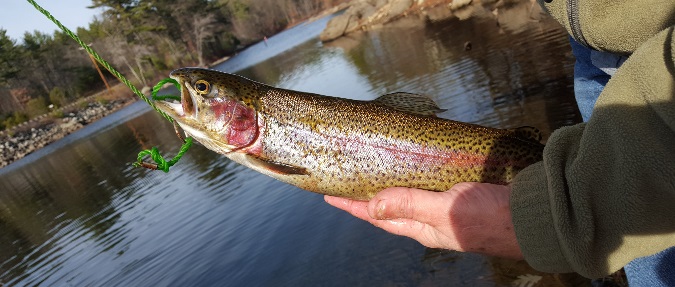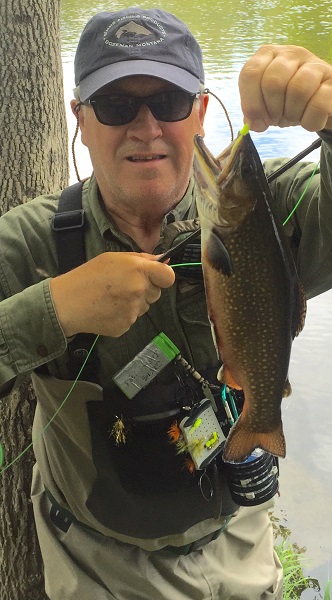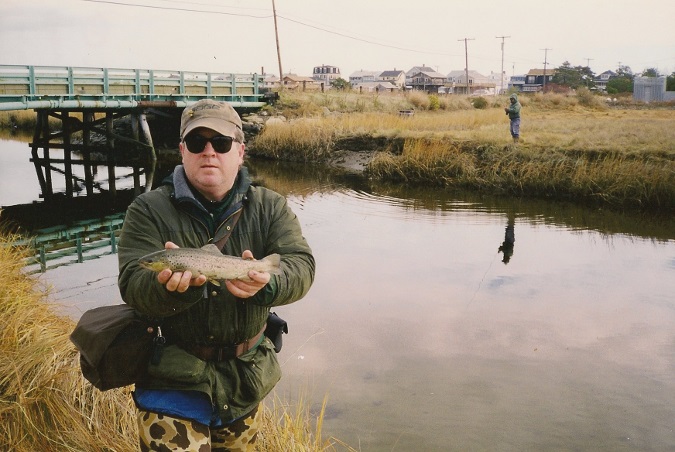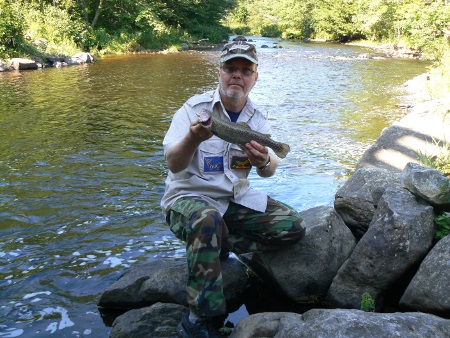Open the cover of any of the numerous print publications and you will find articles about great trout fishing adventures to places like Alaska, Montana, Wyoming and a host of others. Let’s face it, all of these areas offer great fishing opportunities. One area that gets very little attention is New England. For the anglers who call New England home that could be considered a good thing as they have this spectacular fishery all to themselves. For those who don’t live there and have never ventured to this part of the country, then you are missing out on something big.
There are very few places in this country where you can spend the morning fishing for sea-run brown trout, known locally as “salters” in Maine and then spend the late afternoon fishing a remote beaver pond for Native brook trout in Vermont; or trolling one of the big lakes for rainbow, brown and brook trout or even a landlocked Atlantic salmon in the morning then find yourself wetting a fly in a stream for more trout action. New England is one of those places. Over the years I have travelled all across the country to fish, but there is nothing like trout fishing in New England. Fishing here can be a challenge to say the least. Not only does the angler need to outsmart the fish, but they have to contend with the elements and terrain. In New England there are times when trout fishing is more like hunting than it is fishing. Whether it is bushwhacking your way to a remote beaver pond and then stalking the trout or studying maps to find where the Lake trout could be holding on the larger lakes like Lake Champlain in Vermont, Sebago Lake in Maine or Lake Winnipesaukee in New Hampshire, it all amounts to hunting.
Many people ask me what is the best gear to use for trout. My answer is often a two part answer. First, use the best gear that you can afford and second, it all depends on where you are fishing and what you are fishing for. The same gear you use for fishing the big lakes may not be the same you will use for fishing a remote beaver pond. The key is being able to adapt to whatever situation you find yourself in.
While fishing a beaver pond in Vermont I was using a Pflueger eight foot #5/6 fly rod. I probably should have gone a little smaller, but it is the rod that I had. The reel was spooled with #5 tapered head sinking fly line with a #4 leader and a #7 tippet. The flies that produced the best were #16 Elk Hair Caddis and #16 Henryville Specials. Native brook trout are not huge by any stretch of the imagination. In fact a nine inch fish would be considered a trophy.
Larger rivers and streams may call for different equipment depending on water conditions and what the trout want. While fishing the Mascoma River in Enfield, New Hampshire the water was very low. If the water had been flowing normally I probably could have used spinning gear with a small spoon or in-line spinner. In this case, a fly rod was the answer, because due to the low water the fish were concentrated in a very small section of the flowing water and anything not placed perfectly would either spook the fish, get hung up in the rocks or both. Using the same #5/6 rod, but this time using #6 floating line onto which was tied a nine foot 4x tapered leader and a four foot 7x tippet, I was able to hook into a healthy mixture of brown and brook trout. The flies for this day were #16 Bug Miester dry fly, a #16 Pearl Charm and a #16 Morano Special, both of which are streamers.
The Smith River, located in Bristol, New Hampshire was entirely different. Here this section of the river was slow moving, had plenty of bends and deep holes. This situation called for placing the bait deep and keeping it in the holes that I thought that the trout would be lurking. A fly rod wasn’t going to do it here. Instead I opted for a five foot light action spinning rod. The reel was spooled with four pound test monofilament line. The terminal end consisted of a #6 snelled hook with just enough split shot to get the bait, in this case a nightcrawler, down and in the strike zone. I let the bait sit on the bottom for a minute or two before slowly reeling it back in. It took a cast or two before I got a light pull on the line. By slowly lifting the rod tip and keeping it up, I managed to hook into a nice rainbow trout. This day progressed ever so slowly with the end result being a good half dozen rainbow and brook trout both being caught and lost.
New England is not just beaver ponds and rivers. This area is blessed with lakes, both large and small, that host trout and salmon. Considered one of the larger small lakes in New Hampshire is Lake Massabesic which is located between the city of Manchester and the town of Auburn. Whether fishing from a boat or from the shore, the angler has the chance to hook into rainbow, brown or brook trout. Here again spinning gear was the name of the game. Unlike the rivers, the lake allowed me plenty of water to throw lures. In this situation I like to use small stickbaits that mimic the baitfish the trout are feeding on. Live bait is also a good choice here. Another angler, Robert Groman was near me and he was throwing a small chartreuse spoon and it worked wonders. Both of us left the area after catching and releasing our share of 13 inch brown trout.
Larger lakes, which offer very large brown, rainbow and brook trout, as well as lake trout and salmon, call for different tackle and tactics, with each changing with the body of water being fished and the species being targeted. Lake Champlain in Vermont, Sebago Lake in Maine and Lake Winnipesaukee in New Hampshire hold all of the above mentioned species, but each lake is fished differently.
I often Sebago Lake with my good friend Paul Bois who operates White Birch Guide Service. If we are fishing for salmon we usually run two lines straight off the back of the boat. The rods used tend to be medium action with reels spooled with lead core line which keeps the bait or lure about 10 feet below the surface. If using bait we generally run smelt which is the main baitfish of the lake; if we are using lures it is a spoon. If lake trout are the intended species then large stickbaits like jointed Thundersticks or Rouges are run deep with the aid of downriggers. The trick with lake trout is to keep the lure just off of the bottom. While salmon, rainbow and brown trout tend to be anywhere, lake trout and brook trout tend to be in the deepest part of the column.
On Lake Winnipesaukee, the largest lake in New Hampshire, things are done a bit differently. While lake trout are plentiful, salmon and rainbow trout are the target species here. While fishing with old family friend Alan Nute who owns A.J. Bait and Tackle I found out how different the lake was. Leaving out of Paugus Bay, Alan told me that salmon and trout relate more to water temperature than they do to structure. For that reason we were running four lines (two for each of us) two had Salty Special streamer flies and two had Top Gun salmon spoons. The flies were run on two medium action rods coupled with Okuma reels spooled with lead core line. The spoons were run of light action rods whose reels were spooled with six pound test monofilament line. While the flies were run straight off the back of the boat, the spoons were kept at about 35 feet deep with the aid of downriggers. Both the flies and the spoons were taking hits from both salmon and rainbows. At the end of it all we each kept a salmon and a trout, but we threw back many more. The largest salmon we caught measured 19 inches and the largest rainbow trout measured between 19 and 20 inches long.
When talking about trout fishing in New England you have to cover “salters” or sea-run brown trout. My good friend Jack Hanley gave me a call one night and asked me if I would be interested in trying my luck at sea-run brown trout. That was all it took and I was on my way to the mouth of the Kennebec River in Maine. Using my #5/6 fly rod with #5 sinking line I did my best to go after these fish. “Salters” can be big fish, spending most of their time in the ocean and only coming to fresh water to spawn. They also visit the mouths of rivers to feed on sea worms. The water here is very clear, especially at low tide with the problem being that not only can you see the trout, but the trout can see you. Stealth and a properly placed fly is the name of the game here. This is sight casting at the best. Flies of choice are anything that mimics a sea worm. Though I blanked out on this trip, Jack did not.
Like I said in the beginning, New England is trout country. Beaver ponds for Native brook trout; sea-run browns at the mouths of rivers; lake trout, rainbow and brown trout in larger lakes and rivers full of rainbow, brown and brook trout, New England has it all. The possibilities are endless. The key to fishing here is being able to adapt to different circumstances. Lakes are different than beaver ponds and rivers are different than saltwater. If you can roll with the punches you will catch trout. Whether on spinning gear or a fly rod; using bait, flies or lures; trout are great gamefish. Just remember to keep only what you need and release the rest.
By Dana Benner
